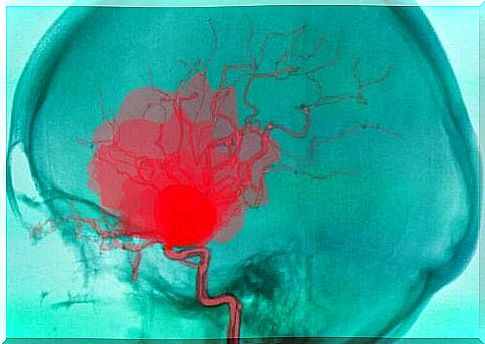What Is Brain Hemorrhage And Why Can It Happen?
Brain hemorrhage is a medical emergency because the death rate is very high and the sequelae are also very common. We will explain how to identify it and how it is treated.

Brain hemorrhage is a serious condition which can endanger the life of the sufferer. It is bleeding inside the brain, which causes blood to flow and not go properly to all parts of the organ.
This is why it is the second leading cause of stroke or stroke. The problem is that the mortality from cerebral hemorrhage, despite current treatments, is still very high. In addition, the sequelae are common in people who survive.
The incidence of this condition increases as one gets older. However, age is not the only risk factor.
What is a brain hemorrhage?
Brain hemorrhage, as we pointed out in the introduction, is bleeding that occurs inside the brain. It usually causes neurological defects that come on suddenly and even a coma.
This is due to the lack of blood supply to the rest of the parts of the brain because the blood does not continue to travel through the blood vessels. It is important to differentiate between brain hemorrhage and intracranial hemorrhage.
In intracranial hemorrhages, in addition to cerebral hemorrhage, there are others that occur inside the skull but not in the brain parenchyma. For example, intraventricular, subarachnoid, subdural and epidural hemorrhage.
One of the main causes of stroke is brain hemorrhage. In fact, it is estimated that almost 15% of all these come from there. In addition, it presents a very high mortality rate, especially the first days.
Related symptoms
Cerebral hemorrhage, as we have just pointed out, is usually associated with a neurological defect that appears suddenly. Depending on the cause of the bleeding, it is possible that the evolution is very fast (in 1 or 2 hours) or that it takes place more slowly. Also, the symptoms vary depending on the area that has been affected.
As in ischemic-type strokes, it is common to see a loss of strength in one half of the body. In other words, if the bleeding has occurred in the right part of the brain, the person’s left leg and arm will be affected.
It is also common for this same side to lose its sensitivity or for tingling to appear. Language can also be affected, as can the ability to understand it. Some people lose their sight in one eye.
It is common to experience headaches, vomiting, loss of consciousness and even a coma. Headaches and vomiting are usually associated with increased intracranial pressure due to the bleeding.

Main causes of brain hemorrhage
Brain hemorrhage can occur for different reasons. Age seems to be one of the most important factors. Indeed, the incidence increases as one gets older and is higher in men than in women.
The main underlying cause is high blood pressure. This is because the cerebral arteries, which are small in caliber, are very sensitive to increased pressure.
Likewise, brain hemorrhage can be triggered by trauma. This is one of the reasons why it is more common in older people, who tend to fall.
Another cause is amyloid angiopathy. It is a disease which consists in the accumulation of certain proteins on the walls of the arteries of the brain. It causes recurrent bleeding because the arteries become more fragile.
Blood changes, and more specifically coagulation disorders, promote the onset of cerebral hemorrhages. However, in a large part of the cases, they are due to the consumption of certain drugs, such as anticoagulants.
Cerebral hemorrhage can also occur in young people. For example, the use of drugs like cocaine or amphetamines increases the risk. In addition, arteriovenous malformations are another relatively common cause.
How is a brain hemorrhage treated?
Brain hemorrhage is a medical emergency. Faced with the slightest symptom, we must immediately call for help.
The first thing to do is to stabilize the patient. As with any other bleeding, it is essential to prevent the person from going into shock.
In addition, intubation is usually necessary to ensure that the patient continues to breathe adequately. Likewise, to stop the bleeding, you can give platelet concentrates or fresh plasma. It is recommended that this be done if the person was on treatment with anticoagulants.
Vitamin K would also help reduce bleeding in these people. In cases of severe arterial hypertension, it is recommended to administer hypotensive drugs. However, this is a very delicate point because if you lower the voltage too much, the damage worsens.
Surgery may be necessary to treat the bleeding in the brain. The intervention consists of extracting the accumulated blood and reducing intracranial hypertension. It is reserved for cases where the bleeding has produced progressive neurological deterioration or if it affects the brainstem.
Possible complications and prognosis
A cerebral hemorrhage involves a very high risk of death. It is estimated that this rate is close to 40%. In addition, people who survive usually have sequelae.
The majority of complications arise from the expansion of the hematoma or edema that forms around it. They can also come from damage in brain tissue due to lack of blood supply. There may be seizures, inability to communicate, and vision problems.
Likewise, it is common for those who survive to have severe headaches and loss of feeling and mobility. The prognosis is poor, although it varies depending on the severity of the bleeding.
Regardless, the majority of patients then require therapy. Rehabilitation therapies can be intended to improve language, mobility or to regain other functions.

The cerebral hemorrhage is severe
There are some aspects to consider for anyone who survives a brain hemorrhage. From this point on, it is essential to strictly control blood pressure. It is also important to adopt a healthy lifestyle to prevent another episode.
Older people who have high blood pressure are at a very high risk of bleeding. It is therefore necessary to try to minimize the risk of falls and to carry out frequent checks of the treatments.









